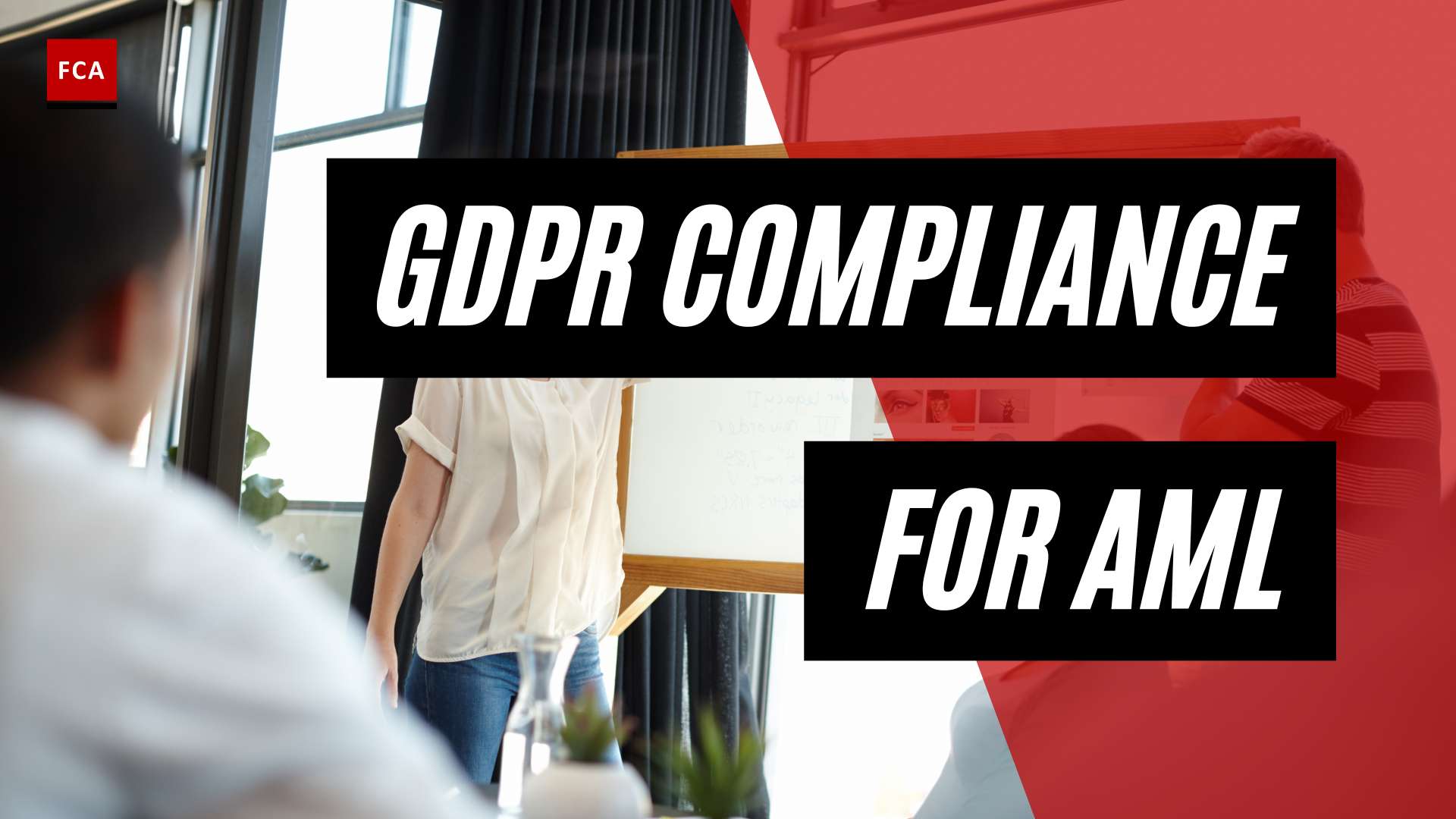AML Training: An Overview
When it comes to combating financial crimes, effective AML (Anti-Money Laundering) training for employees is crucial for ensuring compliance and protecting financial institutions from risks. AML training provides employees with the knowledge and skills needed to detect suspicious transactions, report them, and maintain compliance with regulatory requirements.
Importance of AML Training
AML training plays a critical role in the overall AML compliance program of financial institutions. It equips employees with the necessary understanding of their roles and responsibilities within the system, enabling them to effectively contribute to the prevention and detection of money laundering and other illicit activities.
By receiving comprehensive AML training, employees gain the ability to identify red flags, understand the reporting process, and implement appropriate risk mitigation measures. This training fosters a culture of compliance and helps establish robust internal controls, reducing the likelihood of financial crimes occurring within the organization.
Regulatory Requirements for AML Training
Regulatory bodies, such as the Central Bank of the UAE, mandate that financial institutions provide AML training to their employees. This requirement underscores the significance of AML training in the UAE regulatory framework (AML UAE). Regulatory requirements vary across jurisdictions, but in general, they emphasize the need for financial institutions to establish and maintain effective AML compliance programs.
For example, AML training programs should be part of a broader AML compliance program that includes continuous monitoring and testing by financial institutions to ensure effectiveness. Independent audits conducted by third-party organizations should also be conducted regularly to assess the program’s adequacy and identify areas for improvement (Flagright).
By complying with regulatory requirements and providing comprehensive AML training to employees, financial institutions demonstrate their commitment to combatting money laundering and protecting the integrity of the financial system.
To delve deeper into the various components of effective AML training, regulatory requirements, and strategies for tailoring training materials in the UAE, continue reading the subsequent sections of this article.
Key Components of Effective AML Training
To ensure the effectiveness of Anti-Money Laundering (AML) training, there are several key components that organizations should consider. These components include customization for different roles, incorporation of real-life case studies, and ongoing training and updates.
Customization for Different Roles
AML training should be tailored to individuals based on their roles within the organization. Different employees have varying levels of exposure to AML risks and different responsibilities in the detection and prevention of money laundering activities. By customizing the training content, organizations can provide targeted information that is relevant to each employee’s specific role (Jonathon Bray).
For example, reception staff may need to be trained on recognizing suspicious behaviors, while compliance officers require deeper knowledge of AML laws and regulations. Tailoring the training ensures that employees receive the necessary information and skills to effectively contribute to the organization’s AML efforts.
Incorporation of Real-Life Case Studies
The inclusion of real-life case studies in AML training can greatly enhance its effectiveness. Real-life scenarios help employees understand the practical application of AML principles and regulations. By analyzing actual cases, employees can learn how to identify red flags, report suspicious activities, and make informed decisions in their day-to-day responsibilities.
Real-life case studies provide context and enable employees to develop critical thinking skills when it comes to detecting and preventing money laundering. These case studies can be sourced from industry reports, regulatory agencies, or even internal examples that align with the organization’s specific risks and challenges.
Ongoing Training and Updates
AML training should not be a one-time event. To ensure ongoing compliance and effectiveness, organizations must provide regular and up-to-date training to their employees. The regulatory landscape and money laundering techniques are constantly evolving, making it essential for employees to stay informed and equipped with the latest knowledge.
Regular training sessions, refreshers, and updates should be conducted to reinforce AML principles, introduce new regulatory requirements, and address emerging risks. Training can take various forms, such as workshops, seminars, webinars, or online modules. By keeping employees informed and engaged, organizations can maintain a strong AML culture and mitigate potential risks.
By incorporating these key components into their AML training programs, organizations can empower their employees with the knowledge and skills needed to effectively detect, report, and prevent money laundering activities. Customization, real-life case studies, and ongoing training ensure that employees are equipped to navigate the complexities of AML compliance and contribute to a robust AML program.
In-House AML Training Programs
When it comes to AML training materials, organizations have the option to develop in-house training programs tailored to their specific needs. In-house training offers several advantages and allows companies to customize the training to align with their organizational requirements.
Advantages of In-House Training
-
Customization: In-house AML training programs provide the flexibility to tailor the content, examples, and case studies to the specific roles and responsibilities within the organization. This customization ensures that the training materials are relevant and applicable to the employees’ day-to-day activities.
-
Incorporation of Real-Life Case Studies: In-house training allows for the incorporation of real-life case studies specific to the organization’s industry and operations. By analyzing actual scenarios and discussing how to handle them in line with AML regulations, employees can develop a deeper understanding of the challenges they may face and the appropriate responses.
-
Ongoing Training and Updates: In-house training programs can be designed to include regular updates to reflect regulatory changes and emerging trends in the field of AML compliance. This ensures that employees stay up-to-date with the latest developments and can adapt their practices accordingly. Ongoing training also reinforces the importance of AML compliance as a continuous learning process.
By leveraging in-house training programs, organizations can ensure that their employees receive training materials that are specifically tailored to their needs, industry, and regulatory requirements. This level of customization enhances the effectiveness of the training and empowers employees to apply their knowledge in real-world AML compliance scenarios.
To complement in-house training programs, organizations may also consider incorporating external training providers or online training platforms to provide a well-rounded AML training experience. A combination of different training methods, such as in-house, external, and online, can maximize the effectiveness of the AML training program by offering customization, external expertise, and the convenience of online learning. The selection of training approaches should be based on the specific needs and resources of each organization.
For more information on different training methods, including outsourcing and online platforms, refer to the respective sections in this article.
Outsourcing AML Training
When it comes to AML compliance training, organizations have the option to outsource their training needs to external providers who offer standardized courses covering the fundamentals of AML compliance. There are several benefits to outsourcing AML training, and it’s important to choose reputable training providers that align with regulatory requirements.
Benefits of External Providers
Outsourcing AML training to external providers offers several advantages. Here are some key benefits:
-
Expertise and Specialization: Reputable training providers have expertise in AML compliance and are well-versed in the latest regulatory requirements. They can deliver comprehensive and up-to-date training materials that cover all the necessary topics and ensure employees receive accurate and relevant information.
-
Standardized Training: External providers often offer standardized training courses that cater to employees at all levels. These courses cover the essentials of AML compliance, ensuring that employees receive consistent and uniform training across the organization.
-
Cost and Time Efficiency: Outsourcing AML training can be a cost-effective solution, especially for organizations that do not have the resources or expertise to develop their own training programs. External providers can offer training at scale, saving time and effort for the organization.
-
Objectivity and Impartiality: External providers bring an objective perspective to AML training. They are not influenced by internal biases or organizational culture, which can help ensure that training materials are unbiased and provide a comprehensive understanding of AML compliance.
Choosing Reputable Training Providers
When selecting an external training provider for AML compliance, it’s essential to consider the following factors:
-
Accreditation and Reputation: Choose training providers that have a strong reputation and are accredited by relevant industry bodies or regulatory authorities. This ensures that the training materials meet the necessary standards and are recognized within the industry.
-
Content and Curriculum: Review the training provider’s course content and curriculum to ensure that it covers all the essential topics required for AML compliance. The materials should be comprehensive, up-to-date, and aligned with regulatory requirements.
-
Delivery Methods: Consider the delivery methods offered by the training provider. Some providers may offer in-person seminars, while others may specialize in online training platforms. Choose a provider that offers the delivery method that best suits the needs and preferences of your organization.
-
Track Record and Client Reviews: Research the training provider’s track record and look for client reviews or testimonials. This can provide insights into the provider’s effectiveness in delivering AML training and the satisfaction level of their clients.
By outsourcing AML training to reputable external providers, organizations can benefit from their expertise, standardized training materials, and cost-efficiency. However, it’s crucial to carefully select training providers that meet the organization’s specific needs and align with regulatory requirements.
Online AML Training Platforms
In the modern era, online training platforms have become a popular choice for delivering AML training to employees. These platforms offer numerous advantages over traditional training methods, providing flexibility, accessibility, and comprehensive learning experiences.
Advantages of Online Training
Online AML training platforms offer several benefits that make them an attractive option for organizations:
-
Self-Paced Learning: Online platforms provide employees with the flexibility to learn at their own pace. This is particularly beneficial for individuals with busy schedules or those who prefer to learn at their own convenience. Employees can access the training materials at any time and review the content as needed.
-
Interactive Courses: Many online AML training platforms offer interactive courses that engage learners through quizzes, case studies, and simulations. These interactive elements enhance the learning experience, making it more engaging and effective. Learners can apply their knowledge in real-life scenarios, helping them better understand and retain the material.
-
Progress Tracking: Online platforms often include progress tracking features that allow supervisors and employees to monitor their training completion. This enables organizations to ensure compliance with regulatory requirements and identify areas where additional support or reinforcement may be needed.
-
Convenient Access: With online AML training platforms, employees can access the training materials from anywhere with an internet connection. This eliminates the need for travel or designated training facilities, making it a cost-effective and time-efficient solution for organizations.
Factors to Consider in Choosing an Online Platform
When selecting an online AML training platform, it’s crucial to consider the following factors to ensure the effectiveness and relevance of the training:
-
Content Quality: Choose a platform that offers comprehensive and up-to-date content. The training materials should cover the essential concepts of AML compliance, including regulatory requirements, risk assessment, transaction monitoring, and suspicious activity reporting. Verify that the platform aligns with the latest regulatory guidelines and industry best practices.
-
Customization: Look for platforms that allow customization to suit your organization’s specific needs. Training materials should be tailored to different employee roles and responsibilities within the organization. This ensures that the training content is relevant and applicable to employees’ daily tasks.
-
Tracking and Reporting: The platform should provide robust tracking and reporting capabilities. This allows organizations to monitor employee progress, track completion rates, and generate reports for compliance purposes. These features are essential for demonstrating regulatory compliance and identifying areas for improvement.
-
User-Friendly Interface: A user-friendly interface is crucial to ensure that employees can navigate the platform easily. The online platform should be intuitive and provide clear instructions for accessing and completing the training modules. This promotes a positive learning experience and encourages employee engagement.
By leveraging the advantages of online AML training platforms, organizations can streamline their training efforts, improve employee engagement, and ensure compliance with regulatory requirements. When choosing an online platform, consider the content quality, customization options, tracking capabilities, and user-friendliness to find the best fit for your organization’s AML training needs.
Combining Training Methods
To maximize the effectiveness of AML training, organizations can adopt a hybrid approach by combining various training methods. This approach allows for customization, leverages external expertise, and offers convenience to employees.
Hybrid Approach for Maximum Effectiveness
A hybrid approach to AML training involves combining different training methods, such as in-house training, outsourcing to external providers, and utilizing online training platforms. This approach provides organizations with the flexibility to tailor their training programs to meet specific needs and objectives.
By incorporating a mix of training methods, organizations can take advantage of the unique benefits each method offers. In-house training allows for customization and the incorporation of real-life case studies specific to the organization’s industry and operations. It also provides the opportunity for ongoing training and updates tailored to organizational needs.
Outsourcing AML training to reputable external providers brings the advantage of leveraging their expertise in developing standardized courses that cover the fundamentals of AML compliance. External providers often have a deep understanding of regulatory requirements and can offer training suited for employees at all levels. Choosing reputable providers aligned with regulatory requirements is crucial to ensure the quality and effectiveness of the training.
Online training platforms specialized in AML compliance offer several advantages, including self-paced learning, interactive courses, and convenient access. These platforms allow employees to learn at their own pace and provide tracking of progress, ensuring that the training is completed effectively. When selecting an online platform, it is essential to choose a reputable provider that offers comprehensive and up-to-date content.
Customization, Expertise, and Convenience
The hybrid approach to AML training combines the benefits of customization, expertise, and convenience. In-house training allows organizations to customize the training content to align with their specific policies, procedures, and industry requirements. It enables the inclusion of real-life case studies that are relevant to the organization’s operations, enhancing employee engagement and understanding.
Outsourcing training to external providers brings the advantage of accessing their expertise and industry knowledge. These providers have a deep understanding of AML regulations and can create comprehensive training programs that cover the necessary topics and compliance requirements. By leveraging this external expertise, organizations can ensure that their employees receive high-quality training that meets regulatory standards.
Online training platforms offer convenience and flexibility. Employees can access training materials at any time and from any location, making it suitable for both in-office and remote work environments. The self-paced nature of online training allows employees to learn at their own speed, ensuring comprehension and retention of the material.
By combining these training methods, organizations can create a comprehensive AML training program that maximizes effectiveness and meets the unique needs of their employees and business operations. The selection of the training approach should be based on careful consideration of available resources, regulatory requirements, and the organization’s specific goals and objectives for AML compliance.
For more information on AML training and related topics, please visit our other articles on aml training for employees, aml training requirements, and aml compliance training.
AML Training Materials: Best Practices
To ensure the effectiveness of anti-money laundering (AML) training programs, it is essential to follow best practices when developing AML training materials. These materials should focus on relevance, engagement, and understandability, while also being regularly updated to reflect regulatory changes.
Relevance, Engagement, and Understandability
AML training materials should be created with the aim of engaging employees and ensuring their understanding of key concepts and procedures. To achieve this, the materials should be:
-
Relevant: Training materials should be tailored to the specific needs of the organization and its employees. Customizing the content to address the roles and responsibilities of different individuals within the organization is crucial for effective AML training (Jonathon Bray). For example, reception staff, solicitors, managers, and compliance officers will require training specific to their respective roles.
-
Engaging: AML training materials should employ various instructional techniques to capture employees’ attention and maintain their engagement. This can include using interactive elements, case studies, quizzes, and real-life examples of money laundering activities (Bolder Group). By making the training interactive and relatable, employees are more likely to retain the information and apply it effectively in their day-to-day work.
-
Understandable: It is crucial that AML training materials are presented in a clear and easily understandable manner. The use of plain language, concise explanations, and visual aids can help employees grasp complex AML concepts (Bolder Group). Avoiding jargon and technical terms that may be unfamiliar to employees will enhance their comprehension and retention of the training content.
Regular Updates to Reflect Regulatory Changes
To remain effective, AML training materials should be regularly updated to reflect the evolving regulatory landscape and changes in money laundering trends. Financial regulations and compliance requirements are dynamic, and it is essential to keep the training materials up to date.
Regular updates to AML training materials ensure that employees are aware of the latest AML regulations, best practices, and detection techniques. This enables them to stay vigilant and recognize suspicious activities associated with money laundering and terrorist financing (AML UAE). It is important to emphasize the role of employees in combating financial crimes and the significance of promptly reporting any suspicious activities they encounter.
By providing employees with training materials that are relevant, engaging, and easily understandable, and by regularly updating these materials to reflect regulatory changes, organizations can enhance the effectiveness of their AML training programs. This, in turn, contributes to a stronger defense against money laundering and other financial crimes, ensuring compliance with AML regulations and protecting the organization and its stakeholders from potential risks.
AML Training: UAE Perspective
In the United Arab Emirates (UAE), the significance of AML training cannot be emphasized enough. AML training plays a crucial role in ensuring compliance with local regulations and mitigating the risks associated with money laundering and terrorist financing activities. Failure to comply with AML laws can result in hefty fines and damage to a company’s reputation, making AML training a critical component of the UAE’s regulatory framework (AML UAE).
Significance of AML Training in the UAE
UAE businesses, particularly those in the financial sector, are required to establish robust AML training programs for their employees. Regular AML training enhances the skills of employees, enabling them to recognize red flags associated with money laundering and terrorist financing activities. By equipping employees with the necessary knowledge and tools, organizations can effectively prevent illicit financial activities and safeguard their reputation and integrity (AML UAE).
The UAE’s commitment to combat money laundering and terrorist financing is evident through its implementation of stringent AML regulations. AML training serves as a means to educate employees on their role in detecting and reporting suspicious transactions, as well as understanding their legal and ethical obligations in combating financial crimes.
Regulatory Requirements in the UAE
The Central Bank of the UAE mandates that financial institutions operating within the country provide AML training to their employees. This requirement underscores the importance placed on AML training in the UAE regulatory framework. Financial institutions must ensure that their employees receive comprehensive AML training tailored to their specific roles and responsibilities.
By complying with these regulatory requirements, organizations can demonstrate their commitment to combating money laundering and terrorist financing. AML training programs should cover topics such as the identification of suspicious transactions, customer due diligence, record-keeping requirements, and reporting obligations.
To support effective AML training, organizations can leverage various resources, including AML training online, AML training programs, AML training videos, and AML training seminars. These resources offer comprehensive and up-to-date content to ensure employees stay knowledgeable about the latest AML practices and regulations.
In conclusion, AML training is of paramount importance in the UAE to ensure compliance with local regulations and combat money laundering and terrorist financing activities. By providing tailored and effective AML training, organizations can empower their employees to recognize and prevent financial crimes, safeguard their reputation, and contribute to a more secure financial environment in the UAE.
Tailoring AML Training in the UAE
To ensure the effectiveness of AML training programs in the UAE, it is essential to tailor the training to meet the specific needs of employees. By customizing the training, organizations can enhance their employees’ understanding of AML regulations and equip them with the skills necessary to recognize red flags associated with money laundering and terrorist financing activities.
Meeting Specific Employee Needs
AML training materials should be designed to address the unique requirements of different employee roles within an organization. This approach ensures that employees receive training that is relevant to their specific job functions and responsibilities. For example, employees in customer-facing roles may require training that focuses on identifying suspicious customer behavior, while employees in back-office roles may need training on transaction monitoring and reporting procedures.
By tailoring the training content to each employee’s role, organizations can optimize the learning experience and empower employees to apply their knowledge effectively in their day-to-day duties. This targeted approach helps employees understand the importance of their role in detecting and reporting suspicious activities, contributing to the overall effectiveness of the organization’s AML compliance efforts.
Enhancing Skills in Recognizing Red Flags
One key objective of AML training in the UAE is to enhance employees’ skills in recognizing red flags associated with money laundering and terrorist financing activities. Training materials should provide employees with practical examples and case studies that illustrate common indicators of suspicious transactions or behaviors. This hands-on approach helps employees develop a keen eye for potential risks and enables them to take appropriate actions to mitigate those risks.
To ensure maximum engagement and retention of knowledge, AML training materials in the UAE should be designed to be interactive and scenario-based. This approach encourages active participation and critical thinking, allowing employees to apply their knowledge in real-world situations. Training materials may include videos, quizzes, and practical exercises that simulate common AML scenarios, enabling employees to practice their skills in a controlled environment.
By enhancing employees’ skills in recognizing red flags, organizations can create a culture of vigilance and compliance, reducing the risk of financial crimes and reputational damage.
To comply with regulatory requirements in the UAE, financial institutions must provide AML training to their employees, as mandated by the Central Bank of the UAE (AML UAE). By tailoring the training to meet specific employee needs and focusing on skills development, organizations can ensure that their employees are well-equipped to detect and report suspicious activities, contributing to a robust AML compliance framework.









